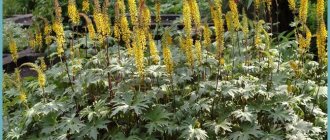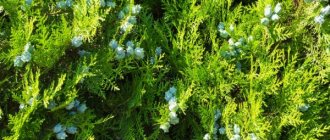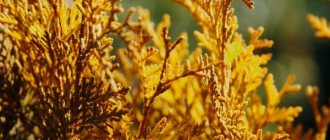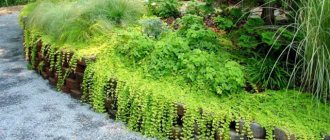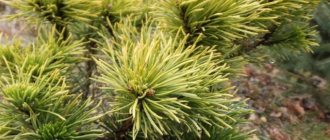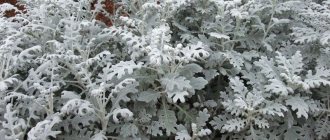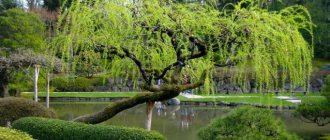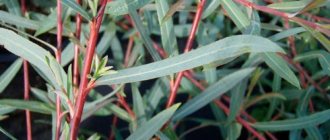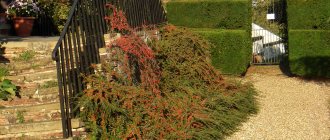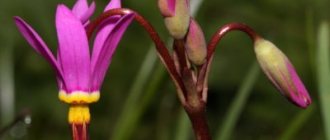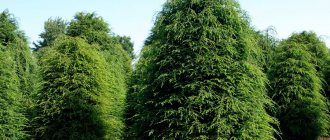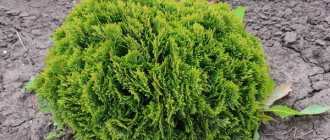Author: Natalya Category: Garden plants Published: February 11, 2019Republished: February 12, 2019Last edits: January 13, 2021
- Growing conditions
- How and when to collect seeds
- Dicentra eximia
flower (lat. Dicentra) belongs to the genus of herbaceous annuals and perennials of the subfamily Dymyanaceae of the Poppy family, known for the original shape of its heart-shaped flowers. Because of them, the French call the dicentra plant Jeannette's heart: an old legend says that beautiful flowers grew in the place where Jeannette's poor heart broke when she saw her savior, the young man who took her, lost, out of the forest, walking down the aisle with another girl. The English call it di. The Latin name comes from the Greek words “dis”, which means twice, and “kentron” - spur, which can be read as “flower with two spurs”, or “double spur”. Dicentra was brought to Europe from Japan in 1816, and it immediately became a decoration for the gardens of aristocrats. Then the fashion for dicentra passed, but more recently it began to appear again in the compositions of landscape designers and in amateur gardens.
Planting and caring for dicentra
- Planting: in September or April-early May.
- Flowering: from May to autumn.
- Lighting: bright sun, partial shade or shade.
- Soil: light, nutritious, moderately moist permeable soil, cultivated to a depth of 20-25 cm.
- Watering: regular and moderate, but more abundant during dry periods.
- Fertilizing: in the spring - with nitrogen fertilizers, during the flowering period - with phosphorus fertilizers, in the fall - with mullein infusion. For the winter, the area is mulched with humus.
- Reproduction: by dividing the bush, cuttings, much less often by seeds.
- Pests: aphids.
- Diseases: tobacco mosaic, ring spot, mycoplasma disease.
Read more about growing dicentra below.
Compliance with the growing regime
A properly planted plant does not create problems for gardeners. Caring for dicentra involves following the watering regime - it should be moderate.
Excessive saturation of water with moisture is not allowed, as the roots may begin to rot. Lack of water is also destructive. Soft water is used for irrigation.
You also need to ensure that the flower bed is weeded and the soil is loosened for better oxygen movement. Loosening and mulching is done in early spring, when the first leaves appear. Due to the instability of the weather, the bed should be covered with non-woven material.
Inflorescences that have already bloomed are regularly removed. Withered leaves are also cut down to stumps. To prepare for wintering in regions with a harsh climate, a flower garden with a dicenter is covered with a layer of peat of 5-7 cm. In warm areas, this is not recommended, since there is a risk that the plant will die.
Superphosphate fertilizers are recommended to be used in early spring during the growth stage, nitrogen-containing fertilizers - during the flowering period of the plant. But in the fall, it is advisable to add mullein infusion under the root, and it is also advisable to mulch with a layer of humus.
Botanical description
There are about 20 species in the genus Dicentra, which mostly grow in the Far East, North America and Eastern China. The height of the dicentra is from 30 to 100 cm. This is a beautiful plant with a fleshy rhizome that goes deep into the soil, with decorative petiolate pinnately dissected green leaves with a bluish tint and reddish or pink, slightly compressed heart-shaped flowers up to 2 cm in diameter, collected in drooping terminal arched racemes. There are two spurs on the corolla of flowers.
The fruit of dicentra is a capsule with black, shiny oblong seeds that remain viable for up to 2 years.
What does a dicentra look like?
Dicentra naturally lives in the Far East, Eastern China, the Korean Peninsula and the North American continent. This exotic flower was brought to Europe from Japan at the beginning of the 19th century and even then gained wide popularity due to its unusually shaped flowers. Looking at dicentra flowers, one gets the impression that delicate defenseless hearts are suspended at the ends of the branches, split at the bottom, from where a tear or a drop of blood is about to fall.
Because of its romantic appearance, dicentra has a second name commonly accepted among people. Russians call it “broken heart”, the British – “bleeding heart”, Germans – “heart flower”. And the sentimental French even came up with an unhappy love story related to the appearance of this flower. A girl named Jeanette got lost in the forest. A young man helped her find her way home, with whom she immediately fell in love and dreamed of meeting him. One day, a wedding procession passed through the village where Jeanette lived. The girl recognized her lover as the groom. Her heart broke from grief, Jeanette lost consciousness and died. This unusual flower grew in that place. The French call it "Jeanette's heart."
Dicentra flowers have long symbolized romantic relationships and were chosen among young people in love. Almost every gardener planted this plant on his plot. Several decades ago, due to the influx of a large selection of other exotic crops into the horticultural market, interest in dicentra subsided somewhat. Currently, designers have turned their attention to the flower, actively including different varieties of the crop in landscape and floral compositions. Their work gave the flower new life and the opportunity to evoke admiring glances with its unusual shape.
Planting dicentra in the garden
When to plant in the ground
Dicentra is planted in the garden in the spring, at the end of April - at the beginning of May, or in the fall, in September. The main thing is that it has enough time to take root in open ground and develop a root system before the onset of cold weather. For dicentra, both an open sunny area and a shady place are suitable, but in bright sun it blooms earlier than in the shade. Dicentra will grow in any soil, but it is most comfortable on nutritious, light, moderately moist, drained soils.
- Hydrangea: planting and care in autumn
The soil for planting dicenters is prepared in advance: spring planting involves preparing the site in the fall, and the site for autumn planting is prepared in the spring. The area is dug up using a shovel and 3-4 kg of humus per m² is added during digging, and then the area is watered with a solution of mineral fertilizer at the rate of 20 g per 10 liters of water.
How to plant
Planting and caring for dicentra in open ground begins with preparing holes with a diameter and depth of 40 cm at a distance of half a meter from one another. A layer of crushed stone or broken brick is poured into the bottom of the hole, then a layer of garden soil mixed with compost is placed in the hole, the root system of the dicentra seedling is placed in the hole and the hole is filled to the top with the same garden soil with compost. If your site has heavy soil, mix it with sand, and if you add limestone chips to the soil, the plant will thank you.
Growing from seeds
The seed method of growing dicentra is rarely used. The seeds are quite whimsical and do not sprout well, especially in temperate climates. But some flower growers, subject to all the rules of agricultural technology, manage to grow full-fledged flowers from them. The seedling method of growing dicentra is not practiced.
Landing dates
It is better to sow seeds in open ground in the fall. For the winter, crops need to be covered with film. The main thing is that before the onset of cold weather, the seedlings take root on the site and their root system becomes stronger.
Spring sowing is also practiced. But the area for growing the flower will need to be prepared in the fall.
Choice of location and lighting
Dicentra is a shade-loving plant. It develops well under the canopy of tall trees. If you plant it in a shaded place, flowering will occur later, but will last longer. But in direct sunlight the plant feels worse. It requires constant watering, the flowers become paler and bloom less often.
Dicentra will feel comfortable in areas with fertile soil with a slightly acidic reaction.
Although it takes root in any soil. Note! The culture is not capricious, but does not tolerate stagnant moisture. Therefore, it is better not to plant it in lowlands, as well as in areas where groundwater is close to the surface.
Preparing the soil and sowing seeds
The soil on the site should be nutritious and well drained. Before sowing, the area must be prepared in advance. If autumn planting is planned, soil preparation is carried out in the spring. Dig it up, add humus (3-4 kg per 1 m2). Dilute complex fertilizer and apply it to the site. Give the soil time to rest for several months and become well saturated with nutrients.
Prepare shallow holes and water them. Place a few seeds in each. Sprinkle with soil. Before frost appears, several true leaves should form on the seedlings. For the winter they need to be covered with film. After sowing, flowering of dicentra occurs only in the third year.
Dicentra care
Growing conditions
Growing dicentra involves moderate watering of the plant, regular weeding and loosening of the soil in the area, since its roots constantly need large amounts of oxygen. Newly hatched seedlings in the spring must be covered with non-woven material so that they are not destroyed by night frosts. Watering is carried out with soft water, more often than usual in dry times, but too much watering can lead to rotting of the roots.
The dicentra is fed with nitrogen-containing fertilizers in early spring, during the flowering period it needs superphosphate, and in the fall the tree trunk circle is watered with mullein infusion and mulched with a layer of humus. Do not forget to remove faded dicentra flowers to extend the flowering period of the plant and maintain its decorative appearance at the proper level.
Transfer
The dicentra bush does not need annual replanting; it grows in one place for 5-6 years, after which you need to look for another site for it. However, once every two years, dicentra in the garden requires replanting, otherwise its roots will outgrow and may rot and partially die.
In September, when the flowering of the dicentra ends, or at the end of April - at the beginning of May, a three- to four-year-old plant is carefully dug up so as not to damage its fragile roots, they are allowed to dry and, in a slightly dried state, the roots are also carefully cut into pieces 10-15 cm long with 3-4 buds, treat the cuts with ash, plant the parts in a permanent place and water them. To make the bush thicker, you can plant 2-3 divisions in one hole. Transplantation is carried out according to the same rules as the initial planting.
- Flower seedlings - how to grow them correctly
Dicentra reproduction
We have just described one of the main methods of dicentra propagation - dividing the bush. Growing dicentra from seeds in amateur gardening is not widely practiced, since it is labor-intensive and unreliable, but in fairness it must be said that there have been cases of successful seed propagation. Sowing of dicentra is carried out in September; dicentra seeds are germinated at a temperature of 18-20 ºC, which takes about a month.
When the dicentra seedlings acquire two pairs of leaves, they are planted in open ground. For the winter, the seedlings are covered with film. Dicentra from seeds blooms in the third year.
Dicentra cuttings are carried out in early spring. To do this, at the beginning of spring, young shoots 15 cm long with a heel are cut, kept in a root formation stimulator for 24 hours and rooted in flower pots with moist, light soil under glass jars for several weeks. Rooted cuttings are planted in open ground only after a year.
Pests and diseases
Dicentra's immunity is high, but despite this, it is sometimes affected by ring spot and tobacco mosaic, as a result of which the young leaves of the plant become covered with stripes and spots, and on mature ones, light rings of an elongated shape are formed, similar in outline to an oak leaf.
Sometimes the dicentra is damaged by a mycoplasma disease, which bends the plant's flower stalks, slows down its growth and colors the flowers yellow or green. As a preventive measure, balance watering the plant, since too frequent or abundant watering leads to a weakening of the dicentra, and it is easier for diseases to attack it. Good results are obtained by disinfecting the soil with a five percent formaldehyde solution, but plants can be planted on the site after such treatment no earlier than a month later.
Among the pests, the ubiquitous aphid settles on the dicenter, which is destroyed by Biotlin or Antitlin.
Diseases and pests of dicentra
Dicentra rarely gets sick, thanks to its high immunity. However, the possibility of diseases and pest damage cannot be completely excluded. The most common infections include tobacco mosaic and ring spot. It is easy to identify these diseases by the appearance of the leaves: young ones become covered with stripes and spots, and more mature ones become similar to oak leaves, known for their pattern in the form of elongated rings.
There is also a possibility of contracting microplasma disease. In this case, the dicentra flowers turn yellow or green and their growth stops.
Dicentra leaves infected with tobacco mosaic virus
To prevent these diseases:
- a month before planting, it is recommended to treat the soil with a 5% formaldehyde solution;
- regularly treat planted bushes against aphids, which are carriers of diseases;
- promptly destroy weeds around the bushes.
Dicentra after flowering
How and when to collect seeds
Since growing dicentra from seeds is far from the best way to reproduce it, there is no point in collecting them, especially since the germination rate of the seeds is low, they are whimsical and may not germinate at all in the conditions of the middle zone.
- Physostegia: growing from seeds, types and varieties
Preparing for winter
In autumn, the ground part of the dicentra is cut off almost to the level of the site, leaving stumps only 3-5 cm high. In addition, despite its frost resistance, perennial dicentra in winter should be under a layer of peat mulch 5-8 cm thick, but no more, so that its roots do not begin to rot under too warm a cover.
Is dicentra poisonous or not?
The most poisonous part of the dicentra is the root. But some varieties have leaves and stems that are poisonous because they contain alkaloids. Therefore, you need to work with the plant carefully, using special gloves. Contact with skin may cause irritation. If a small amount of juice gets inside the body, then you should expect gastrointestinal upset. In case of severe poisoning, the effect will affect the nervous system. Fleshy roots can protrude above the ground and be eaten by animals, which will not have the best effect on their health. Therefore, you need to ensure that the roots of the dicentra are under the soil.
Types and varieties
Dicentra eximia
Either dicentra exceptional or superb is native to the western regions of North America. This is a perennial dicentra up to 20 cm high with fleshy leafless stems, palmate leaves from small lobes forming dense basal rosettes, and pink flowers up to 2.5 cm in diameter, collected in arched racemes up to 15 cm long. This species blooms in the third decade May, flowering lasts up to three months.
Dicentra has excellent winter hardiness - it can withstand frosts down to -35 ºC, but it is advisable to mulch it for the winter. The species was introduced into cultivation in 1812 and has a white-flowered form.
Beautiful Dicentra (Dicentra formosa)
Introduced to Europe from British Columbia, where its range extends in moist forests to central California. This species reaches a height of 30 cm, its green, bluish palmate leaves on long petioles are collected in a basal rosette, and small purple-pink flowers up to 2 cm in diameter form inflorescences 10-15 cm long. They bloom from late May to autumn.
Plants of this species are winter-hardy, but it is better to cover them for the winter. Dicentra has been beautiful in culture since 1796. The most famous varieties:
- Aurora - this variety has white lower petals, and the upper ones have a pale pink tint at the peduncle;
- King of Hearts is a dicentra with deep pink flowers and bluish-gray leaves.
There is a subspecies of dicentra beautiful, dicentra oregano, which is endemic to southwestern Oregon and California. It has creamy white flowers with pink frost or hot pink, while the Alba form has white flowers.
Dicentra cuccularia
Grows in eastern North America, in the states of Washington and Oregon. It has a rhizome consisting of small tubers, finely dissected gray-green leaves forming cushions of rosettes, peduncles up to 30 cm high, on which white flowers with long spurs are formed.
This plant is often grown as a potted plant. The cultivar dicentra capulata Pittsburgh has pink flowers, and recently a form with yellow-lemon flowers has appeared.
Dicentra chrysantha
It grows on the slopes of California at an altitude of 1700 m, as well as in Mexico. This is a larger species than those already described, it reaches a height of 45 to 152 cm, blooms from mid-spring to early autumn with bright yellow flowers with two intricately curved petals. In culture this species is quite whimsical, but in nature it very quickly populates fire sites.
Dicentra uniflora
Distributed in North America from Washington state to the Sierra Nevada, as well as in Idaho and northern Utah. Plants of this species are sometimes called "ox's head" because of their peculiarly curved petals. Single flowers appear from February to July on peduncles up to 10 cm high, and the feathery leaves grow separately from the peduncles. This species is as attractive as it is difficult to cultivate.
In addition to the described species, dicentras pauciflora, whitish-yellow and Canadian are also known.
Breeding rules
Sowing seeds rarely brings results. This is difficult to do, but even in this case the plant will bloom no earlier than the third year. If you decide to experiment, then sow in late autumn and cover the planting with protective film for the winter.
Seeds for seedlings are germinated for a month at a temperature of 20 degrees. When several leaves appear on the seedlings, the seedlings can be transferred to the garden.
Dividing the bush is more often used, especially since it is recommended to regularly carry out such an operation every 2 years. You will also be required to replant the dicentra every five years. The plant is dug up in September after flowering and left to dry for a short time. Then you need to cut off parts with a length of up to 15 cm with a knife.
The main thing is the presence of 3-4 kidneys. The cut areas must be treated with ash. The new plant is transferred to another place, after moistening the planting. Several divisions can be placed in one place. This will give you a fuller bush.
In early spring, you can also make cuttings by choosing shoots 12-15 cm long with root shoots. You should carefully select young shoots so that there is a “heel” on the cuttings. The selected shoot must be kept in water with a growth stimulating agent, and then planted in pots for rooting.
During the germination process, it is necessary to ensure soil moisture, for which the container with soil is covered with glass, for example a jar. In a covered state, you need to keep the planting for several decades. Planting in the garden is done only every other year in the spring.
